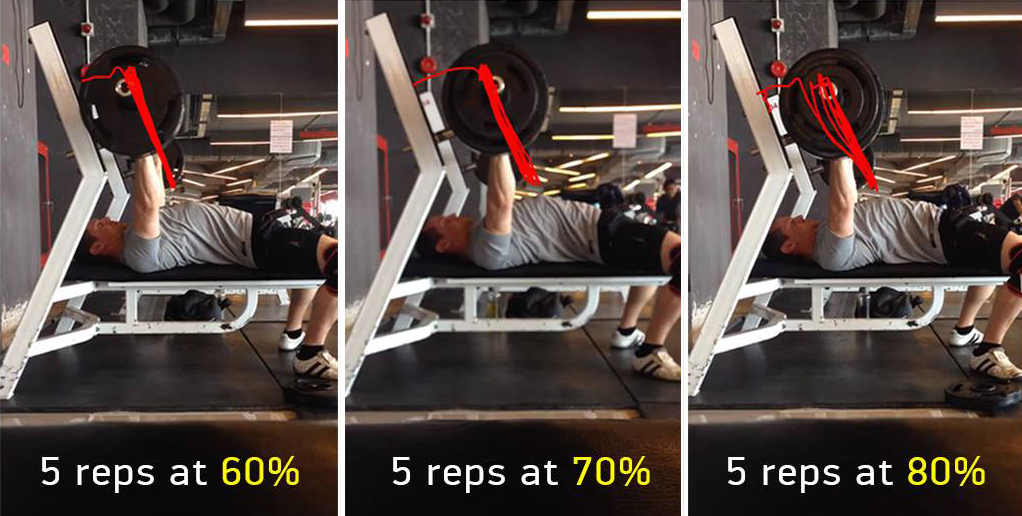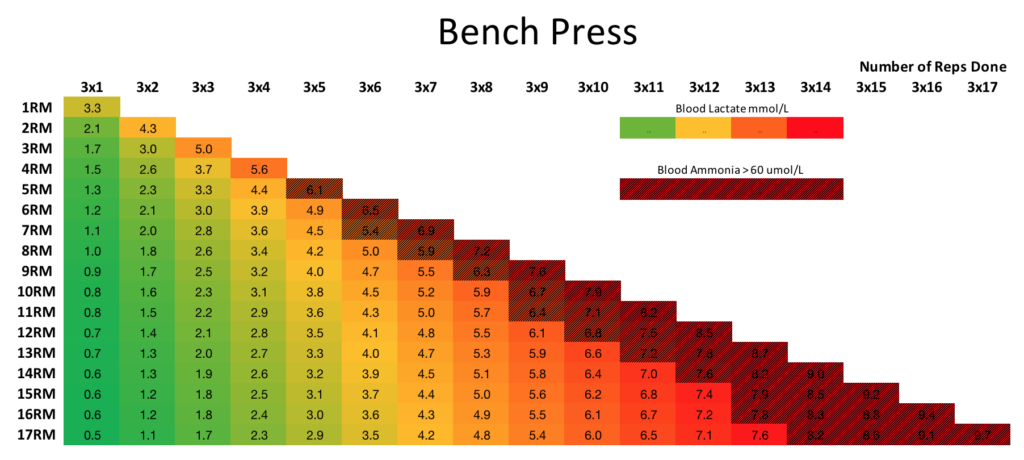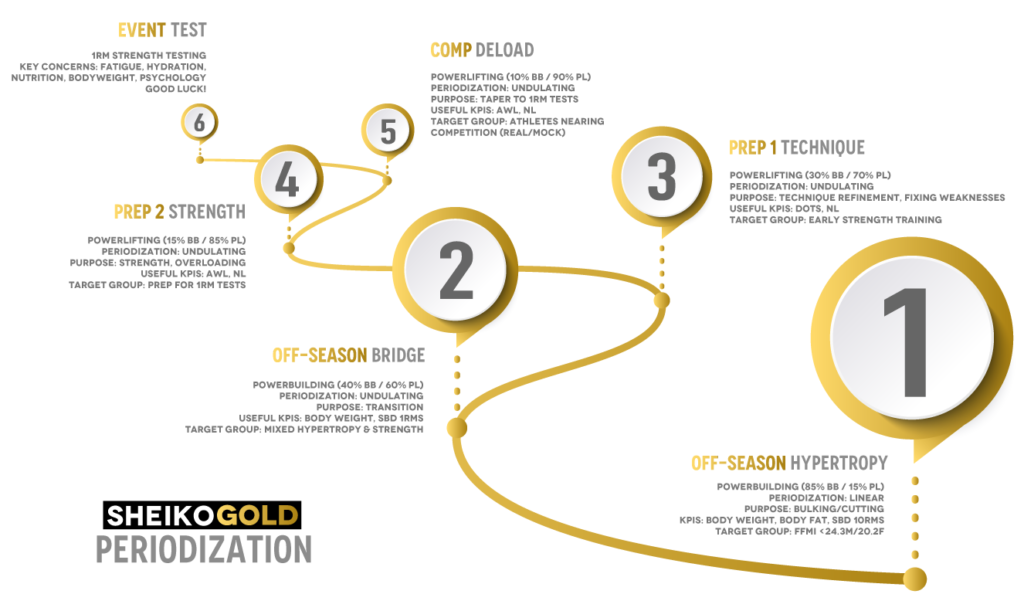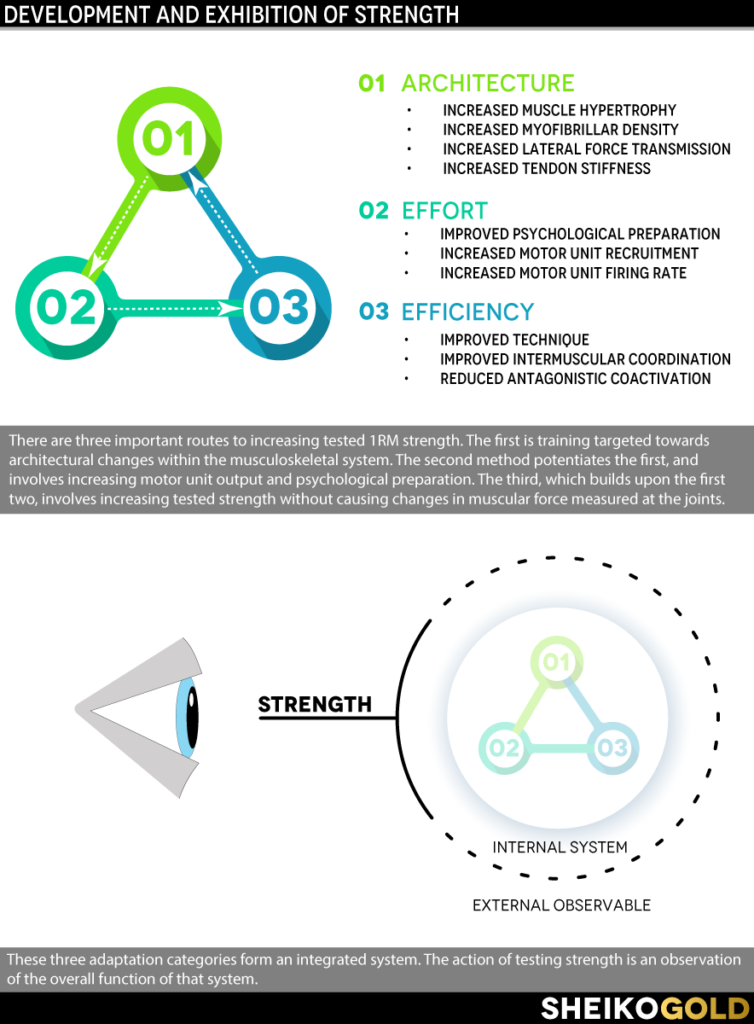Here’s what you need to know to make the most of Sheiko programs
So you want to get stronger and you’re thinking about using a Sheiko program. Here are a few things to think about as you pursue your goals.
What kind of strength are you looking for, exactly? Testing a 12 repetition maximum is a test of how long you can maintain a certain level of strength. A vertical jump test evaluates your high-velocity strength while a 1RM looks at your low-velocity strength. You could also test your isometric (zero velocity) or eccentric (negative velocity) strength.
Training for strength is therefore defined by the specific test of strength you plan to use. Sports scientists like to call this specificity and it’s not that much different than preparing for an exam. In either case, there are many things you could do but not all will be helpful on the test. Strength training used to be mainly an art though things have progressed to the point where that is no longer the case. We now have some pretty solid science behind the training which we’ll dig into shortly.
On this page, we’ll limit the scope of discussion to strength training for 1RM tests of the squat, bench press, and deadlift using Sheiko programs. Before the more aesthetically minded folks turn away, powerlifters–who participate in a sport that formalizes these tests–also need to maximize their muscle mass. Bodybuilder or powerlifter, there’s a large degree of overlap between the general methods and outcomes, especially in lower to middle weight classes. The differences between the two sports are instead largely in their vastly different late-stage competition preps, while the early days can be hard to tell apart. Indeed, successful crossovers between the two sports are not that uncommon.
Continuing on, training to improve 1RM test performance depends on the following adaptations:
- Increased motor unit recruitment – Muscle fibers are grouped together in bundles called units. The motor units with the greatest force potential fire only after all others have been recruited. Recruiting these high-threshold motor units and training them is a primary goal.
- Increased motor unit firing rate – A muscle fiber that fires 60 times per second (60Hz) will generate more force than one that fires at 30Hz. Once all available motor units have been recruited (@approx. 80% 1RM) force can only increase through an increase in firing rate.
- Improved psychological preparation – All force ultimately originates from the mental command to produce force. A large number of factors can erode this central command to some degree and attenuate force output.
- Improved technique – Making improvements in the bar trajectory, for example, will increase the amount lifted without any change in muscular force at the joints.
- Improved intermuscular coordination – Multiple muscle groups participate in compound exercises. The better they coordinate their activities across the joints, the greater the overall force potential.
- Reduced antagonistic coactivation – Less net elbow flexion force is achieved when doing bicep curls if the triceps are simultaneously under tension. This is related to intermuscular coordination.
- Increased muscle hypertrophy – Come on, you guys all know this one.
- Increased myofibrillar density – Adding more muscle fibers without increasing muscle volume leads to an increase in density.
- Increased lateral force transmission – Only a fraction of contracting muscle fibers exert force along the muscle. A great deal of force is transmitted instead laterally to the adjacent collage layer via bonds called costameres. The number of these bonds can increase through training
- Increased tendon stiffness – The muscle and tendon are like two springs in series. A stiffer tendon allows the muscle fibers to generate more force.
These are the most important adaptations needed. Perhaps it is more convenient to condense these adaptations into simpler categories. To get stronger, you need to do three things:
- Increase effort
- Improve efficiency
- Promote beneficial architectures
That’s better. The following infographic summarizes the above.
Any strength training protocol that touches on these areas will very likely cause an increase in strength.
To illustrate how to create these adaptations in preparation for 1RM tests, let’s dissect an enormously successful methodology in the sport of powerlifting popularized by Boris Sheiko. His athletes have racked up 117 gold, silver, and bronze medals at European and World Championships as of 2019. His methodology introduced the world to the seemingly paradoxical idea (at the time) of increasing maximal strength exclusively through the use of a large volume of submaximal work. This violates common intuition that suggests maximum strength requires training with maximum effort, as the principle of specificity would dictate.
The Underlying Philosophy of Sheiko Programs
Train heavy and do it often.
We track these two prescriptions – essentially measures of intensity and volume – with the average weight lifted (AWL) and the number of lifts (NL), respectively. As we know, increasing one necessarily decreases the other. You can lift more weight, but you’ll lift it fewer times. Does this sound like a high-school math problem to anyone?
If training intensity and training volume can both increase maximum strength, but increasing one causes a reduction in the other, what values of each should we use to maximize strength?
Math Teacher
Boris was a good student and decided to find the answer. The empirical evidence he compiled suggests it is found when AWL is held relatively constant at 68-72% of 1RM while NL is varied according to individual tolerance. Do note that this applies across the board. Beginners all the way up to elite athletes follow the same prescription.
| % of 1RM | Sets | Reps |
|---|---|---|
| 50% | 1 | 5 |
| 60% | 1 | 4 |
| 70% | 1 | 3 |
| 80% | 5 | 3 |
| NL | 27 | |
| Avg | 70.4% |
It’s worth expanding a bit more on NL since it imposes some additional constraints. The monthly (and annual) total NL is a key performance indicator (KPI). Think about what that means for a second. We’re not looking at the volume in a single workout. We’re taking a top-down view. Do more one day and fatigue sustained in that workout means you’ll probably need to do less on another day. That feels like another one of those math problems again.
Large volume workouts create a stronger training stimulus than low or moderate volume workouts, but also impose greater costs in terms of fatigue and require more extensive recovery periods. Knowing this, how do you achieve the greatest volume so as to maximize the training stimulus over time?
Math teacher
The answer is quite simple. Since fatigue is the limiting agent, seek to minimize fatigue in training wherever possible.
Let’s examine the practical significance of this with some context.
Sheiko Programs use Volume-based Strength Training
Tracking the barbell path and/or muscular activity over the span of multiple repetitions and intensities shows a progressive deterioration of motor consistency as fatigue accumulates. Reps #4 and #5 in the set at 80% 1RM are where the path finally breaks from the pattern established with lighter weights.

Restricting the set in the example above at 80% to 3 reps instead of 5 would give good exposure to tension while also reinforcing a consistent motor pattern.
What will this submaximal effort set at 80% do?
>Minimize fatigue
Pinto et. al., (2013) examined muscle activity in the bench press at varying levels of voluntary contraction and observed increased activation across intensities with near-maximal activity obtained at 80% MVC.
>Increase motor unit recruitment
Moreover, the barbell velocity at 80% would be closer to the velocity of a 1RM test. Therefore, the intermuscular coordination reinforced by 3 reps at 80% is more specific than the intermuscular coordination reinforced at 50%.
Schoenfeld et. al., (2016) observed significant differences in triceps brachii (but not pectoralis or anterior deltoid) activity at 50% and 80% in the bench press.
>Increase intermuscular coordination
Here’s another way to look at what’s going on with sets in various proximities to failure. 3×3 with an 8RM barely increases markers for metabolic stress above baseline. In other words, these sets are low-cost yet high-quality work. The technical terminology applicable here is a high stimulus to fatigue ratio.
Then compare that to the approximately 300% increase in stress caused by 3×10 at 10RM.

Probably the most familiar embodiment of this principle is the table put together by Soviet sports scientist A.S. Prilepin.
| % of 1RM | Reps per Set | Optimal Total Reps | Range of Total Reps |
|---|---|---|---|
| 55-65% | 3-6 | 24 | 18-30 |
| 70-80% | 3-6 | 18 | 12-24 |
| 80-90% | 2-4 | 15 | 10-20 |
| 90+% | 1-2 | 4 | 1-10 |
This all works great if you have a very reliable 1RM to base work off of. There are a lot of factors that can influence the results of a 1RM test on a particular day. 80% could actually be 70% if the 1RM test did not go well and underreported strength. Conversely, a highly arousing test environment could facilitate greater 1RMs than are achievable on typical training days.
So instead of:
80% of 100kg, which is 80kg.
It’s probably more like this:
80% of 95kg to105kg, which is 75kg to 85kg.
Solutions to this uncertainty can involve either correction to the assumed 1RM by inflating or deflating it or correction to the assigned weight by increasing or decreasing it as needed. Corrections are typically estimated based on subjective difficulty (RPE/RIR ratings). Alternatively, a more objective method of making corrections is to track and respond to velocity loss in real-time. As fatigue builds up across a set, force production is impaired and velocity slows as a consequence (Knuth et. al., 2006).
A recent meta-analysis compares velocity-loss-guided-training to traditional training and provides some velocity loss landmarks:
When sets and relative intensity were equated, velocity loss thresholds ≤ 25% were superior for promoting strength possibly by minimizing acute neuromuscular fatigue while maximizing chronic neuromuscular adaptations, whereas velocity loss thresholds > 20–25% were superior for promoting hypertrophy by accumulating greater relative volume.
The Effect of Load and Volume Autoregulation on Muscular Strength and Hypertrophy: A Systematic Review and Meta-Analysis
So far, Sheiko programs seem like they’re probably hitting the following areas when we factor in a high NL and overlap between areas:
- Increased motor unit recruitment
- Improved intermuscular coordination
- Reduced antagonistic coactivation
- Increased myofibrillar density (when NL is high)
However, the great emphasis placed on minimizing fatigue, which is necessary for hypertrophy-specific training yet has detrimental effects on strength, means Sheiko programs likely do not maximize hypertrophy. But hey, that’s what periodization is for, right? Simply do highly fatiguing work early in your training cycle. Even when you do find more hypertrophy-oriented work in Sheiko programs, the effort to minimize fatigue is still apparent. After a short warmup, approximately 30 reps are performed with 70%. Instead of 3×10, as a bodybuilder might do, the reps are spread out in a staggered fashion across more sets. While fatigue is necessary for hypertrophy, the most fatiguing sets are towards the end.
| % of 1RM | Sets | Reps |
|---|---|---|
| 50% | 1 | 5 |
| 60% | 1 | 4 |
| 70% | 1,1,1,1,1,1,1 | 3,7,5,8,4,9,6 |
| NL | 52 | |
| Avg | 67.1% |
Can’t you just use a low fatigue method for the bench press and target the triceps for hypertrophy with assistance exercises? The answer really depends on the goals. If you want to maximize strength in the near term you wouldn’t want to inhibit the force potential of your triceps and also potentially reduce the effectiveness of your primary bench work. The answer is a little different if you’re thinking about longer-term training results. In that case, since time is available, periodize your training instead of mashing it all together. Frontload your training period with hypertrophy-focused work then switch to hypertrophy maintenance when doing strength work.
Related broscience: people training for maximum strength don’t want to get bigger because that’ll put them in a higher weight class where they’ll be less competitive. That’s nonsense, of course. The amount of muscle you have on your skeleton (i.e., how thick you are) is the single greatest predictor of your 1RM. This bit of broscience is likely driven by the detrimental effects of fatigue caused by hypertrophy-style training, at least in the short term.
Variations, technique, and opportunistic loading
What’s all the fuss about fatigue anyway? Training that is highly fatiguing causes a post-exercise inflammatory response, which in turn leads to CNS inhibition of high threshold motor units. These motor units correspond to the muscle fibers with the greatest strength and potential for growth. Inhibiting these ultimately reduces strength and makes workouts targeting these critical muscle fibers less effective. For a nice review on the subject check out this excellent resource.
CNS fatigue can be caused by other forms of training as well. Endurance training is an even more potent trigger than hypertrophy-specific training. Perhaps not surprisingly, sleep deprivation has similar effects. Mood and energy drop too and your subjective perception of effort increases. In situations where fatigue decreases access to high threshold motor units, Sheiko Gold might assign the following:
| % of 1RM | Sets | Reps |
|---|---|---|
| 50% | 1 | 5 |
| 60% | 1 | 5 |
| 70% | 1 | 5 |
| 75% | 4 | 5 |
| NL | 35 | |
| Avg | 68.6% |
These lighter sets afford an opportunity to reinforce intermuscular coordination with minimal fatigue costs.
Use of variations to improve technical efficiency
Assigning sets below 80% means muscle activity will be submaximal (when using a self-selected tempo). Beyond helping dissipate fatigue, these lower intensities also present an opportunity to selectively target one area over another, which can be useful for technique development. For example, a relatively upright squat at 70% might turn into an excessively hip-dominant squat at 80% and above. In such cases, a squat with a slower concentric tempo might be assigned for sets at 70-75%. The overall muscle activation headroom provided by lowering the weight allows for precise corrective action directed at the problem area.
Side note: Are you taking videos of your harder sets? It’s a good idea to regularly get your lifts on video and examine them afterward. Doing so can really help speed up technique improvements.
Use of variations to reduce fatigue
Let’s suppose you bench press every day. Strain builds when there is stress and insufficient recovery. One way around the problem is to juggle the stress so one area rests while another does work. For example, you could bench press with a wide grip Monday and place greater stress on your chest. Tuesday you could bench with a narrow grip to reduce stress on your chest. Wednesday you could shift to bench with a medium grip to balance the stress. On Friday you might shift to bench with a slingshot. And so on.
It is not uncommon for the squat, bench, and deadlift to each have a dozen or more variations.
In general, variations of the main lifts can be used to:
- reduce fatigue in specific areas
- fix problems in specific areas
A special application of variations involves assisted overloads. For example, squats might be done with a reverse band setup, bench presses can be done with boards, and deadlifts can be done from blocks. In each case, the weight used is higher than typically used (e.g. 90% vs 80%) without the same fatigue cost of using the higher weight directly. A 90% bench set will be more fatiguing than a board press with the same weight. Such variations allow for a higher stimulus to fatigue ratio.
Putting it all together

Since highly fatiguing hypertrophy-specific work is both essential in the long term and detrimental in the short term, a logical periodization sequence starts with frontloading fatigue then moves on from there while trying to maintain beneficial adaptations achieved during prior training. Along similar lines of thought, overloading is best used at the end of a training period and close to the tests.
- Increased muscle hypertrophy (fatiguing sets) Off-season
- Improved technique (corrective variations) Prep 1
- Increased motor unit recruitment (heavy or explosive sets) Prep 1
- Improved intermuscular coordination (quality reps x heavy) Prep 1
- Reduced antagonistic coactivation (quality reps x heavy) Prep 1
- Increased myofibrillar density (volume x heavy) Prep 2
- Improved psychological preparation (overloading variations) Prep 2
- Increased motor unit firing rate (overloading variations) Prep 2
- Increased lateral force transmission (overloading variations) Prep 2
- Increased tendon stiffness (overloading variations) Prep 2
In layman’s terms, get bigger first. You might miss some of the finer points of technique at this point but size matters more. Once you’ve got that out of the way, traditional Sheiko programs put the finishing touches on your technique and get it ready for overloading. Done? Load up the weights for a while and get ready to test. Deload a bit right before you do.



